Milton Industrial School for Boys, Gravesend, Kent
The Milton Industrial School for Boys was established in 1875 at Parrock Hall on Joy Road, Milton, near Gravesend. It was operated by the National Children's Home (NCH) with Henry Tyson appointed as its governor. The school received its official certification on March 15th of that year to accommodate 160 boys aged from 8 to 14 years. Most of the boys were 'delinquents' placed there by magistrates' courts although there were also a few voluntary cases.
An interesting picture of the school is provided by the report submitted by government inspector James G. Legge following a visit to the school in 1896:
MILTON INDUSTRIAL SCHOOL, GRAVESEND, OCTOBER 23, 1896.
Total number in School, 158; Voluntary Cases, 40; on License, 1; Absconders, 0. Four boys over 15. Mr. and Mrs. Tyson, Superintendent and Matron; Schoolmasters, Mr. Jewell and Mr. Wilson; tailor, shoemaker, drill-master, farm-bailiff, gardener, sewing-mistress, nurse, cook, two laundresses. There are two matrons in charge of little boys. Bandmaster four times a week.
An old country mansion, situated in a cup-shaped depression of the heights to the south of Gravesend. The situation is a damp one, and the buildings require constant attention to prevent their falling into decay. The modern additions, e.g., the schoolroom and the junior department, are more suitable for the purposes of a School than the main building. The latter is a specially useful institution, where some thirty of the junior boys are under female care. About the School are twenty acres of pasture, in which are kept thirty cows.
Singing (sol-fa) very fair. Geography is taken all through, and is very fair. Recitation all through is good. Mental Arithmetic is fair generally. A few object lessons have been given. Development of intelligence is very fair, though weak in the fifth, owing to the fact that the ex-fifth boys have not been regular in their attendance. Composition in the fifth is very fair. Some History lessons had been given. Drawing is taken all through the school, and seemed to me distinctly good.
The normal distribution at work appears to be as follows:— Shoemakers, 20; tailors, 20; sewing-room, 20; laundry (three days a week), 10; house and kitchen, 10; farm and garden, 18. Up to Standard II, boys attend school full time. The work in the shoemaker's and tailor's shop is institutional, and the accommodation for neither in the present building is first-rate. There is a brass band of twenty-six under careful instruction. Emigration to Canada is largely used as a means of disposal for the boys.
There is a good play-yard, and a capital field for cricket and football. Outside matches are frequently arranged. The School won a banner from all the elementary schools of the town last year, and consequently leave them to fight it out among themselves this year. Good physical and military drills are given, and capital instruction on single gymnastic apparatus. The display on the horse was first-rate. There is a library, and boys' papers are taken; newspapers are seen occasionally. There is a magic lantern, which comes in useful for entertainments in the winter. Visits are allowed once a quarter. Besides the band there is a team of handbell ringers.
State of health is good. No death. One boy appears to have caused some anxiety through being subject to fits. One developed scarlet fever in August last, and another at the beginning of this month. There has also been one case of ophthalmia. The doctor visits once a week, and as often as he is required. A report is drawn up by him on the health of the boys every quarter, as well as one on the sanitary condition of the premises. There is a detached infirmary.
Conduct and discipline good. The list of punishments is a short one, and the offences not of a serious character. A dozen cases of pilfering are recorded, and about six of dirty habits. Sergeants of companies, who are appointed for good conduct for the period of a month, obtain one shilling for the month The money is banked for them, but can be withdrawn on suitable occasions, or the balance given on leaving the School. Occasionally prizes are given for proficiency in school work; several of the boys who work in the industrial departments receive a small wage.
The boys are a healthy and cheerful-looking lot, of manners milder than the average, perhaps; but they are full of pluck, as may be seen when they are watched at play, or at work on the horse. The removal to a new site will, I hope, give the School fuller scope, particularly for workshops, gymnasium, schoolroom, bath, &c., &c., without in any way sacrificing the good features of homeliness and kindliness which distinguish it.
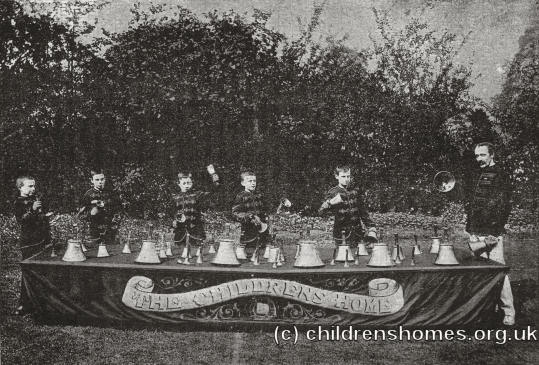
Milton Industrial School, Gravesend — handbell ringing, 1890s. © Peter Higginbotham
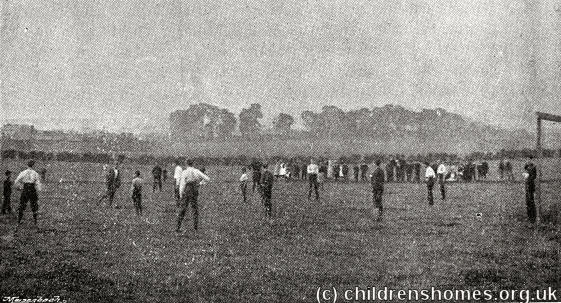
Milton Industrial School, Gravesend — football, 1890s. © Peter Higginbotham
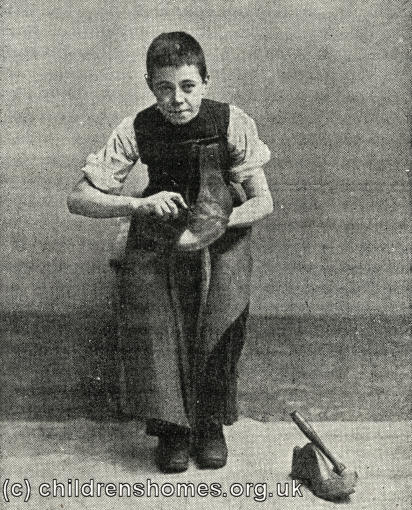
Milton Industrial School, Gravesend — shoemaking, 1890s. © Peter Higginbotham
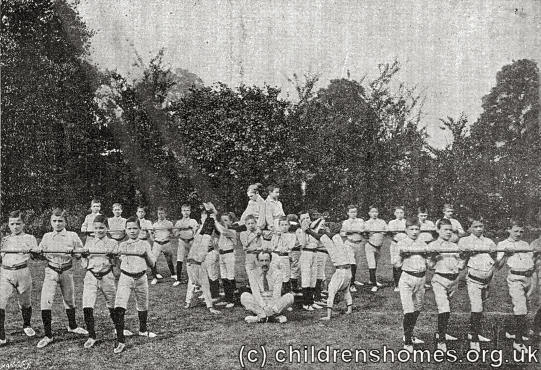
Milton Industrial School, Gravesend — athletics, 1890s. © Peter Higginbotham
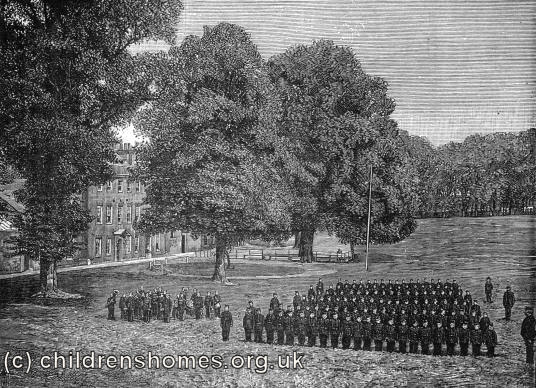
Milton Industrial School, Gravesend — boys at drill, 1890s. © Peter Higginbotham
In 1898, the school — still in the charge of Henry Tyson — moved to new premises at Farnborough in Hampshire. The main school building at Gravesend has now been converted to flats.
Records
Note: many repositories impose a closure period of up to 100 years for records identifying individuals. Before travelling a long distance, always check that the records you want to consult will be available.
- Action For Children (formerly the National Children's Home). Can provide access to their own records for individuals who were adopted through the charity or who resided in one of its homes. Help also for those searching for family history information.
Census
Bibliography
- Bradfield, William The Life of the Reverend Thomas Bowman Stephenson (1913, Kelly)
- Curnock, Nehemiah The Story of the Children's Home (C.H. Kelly, 1901)
- Higginbotham, Peter Children's Homes: A History of Institutional Care for Britain's Young (2017, Pen & Sword)
- Horner, Francis Shadow and Sun (Epworth Press, 1920)
- Howard, Philip J Philip: a Strange Child (Dalkeith Publishing, 2007)
- Philpot, Terry Action For Children (Lion, 1994)
- Walpole, Cecil F. Golden Links (Epworth Press, 1941)
Links
- Action For Children.
- Their History — a website on the homes by a former resident.
- Growing up in the NCH — a forum for those who spent time in NCH homes.
Films
- Scenes from various NCH Homes — 1960s film footage.
- NCH Documentary (1954) Part 1 — Arriving at Harpenden.
- NCH Documentary (1954) Part 2 — Harpenden Oval.
- NCH Documentary (1954) Part 3 — Annual Convocation, Alverstoke
- NCH Documentary (1954) Part 4 — Special facilities at Danesford, Chipping Norton, Harpenden and Frodsham.
- NCH Documentary (1954) Part 5 — Founders Day at Princess Alice Orphanage; training at Harpenden.
- NCH Documentary (1954) Part 6 — Harpenden.
- NCH Documentray (1964) Part 1 — Disabled and special needs at Harpenden and Chipping Norton
- NCH Documentary (1964) Part 2 — Disabled and special needs children at Harpenden, Edgworth, Chipping Norton.
- NCH Documentary (1964) Part 3 — Harpenden, Edgworth, Chipping Norton.
- NCH Documentary (1964) Part 4 — Alverstoke.
- NCH Documentary (1964) Part 5 — Alverstoke.
- NCH Documentary (1964) Part 6 — Alverstoke.
- NCH Frodsham (1960s) Part 1
- NCH Frodsham (1960s) Part 2
- NCH Brackley (1960s)
- Danesford School (1960s)
Except where indicated, this page () © Peter Higginbotham. Contents may not be reproduced without permission.


